#API Online Training
Explore tagged Tumblr posts
Text
AI Automated Testing Course with Venkatesh (Rahul Shetty) Join our AI Automated Testing Course with Venkatesh (Rahul Shetty) and learn how to test software using smart AI tools. This easy-to-follow course helps you save time, find bugs faster, and grow your skills for future tech jobs. To know more about us visit https://rahulshettyacademy.com/
#ai generator tester#ai software testing#ai automated testing#ai in testing software#playwright automation javascript#playwright javascript tutorial#playwright python tutorial#scrapy playwright tutorial#api testing using postman#online postman api testing#postman automation api testing#postman automated testing#postman performance testing#postman tutorial for api testing#free api for postman testing#api testing postman tutorial#postman tutorial for beginners#postman api performance testing#automate api testing in postman#java automation testing#automation testing selenium with java#automation testing java selenium#java selenium automation testing#python selenium automation#selenium with python automation testing#selenium testing with python#automation with selenium python#selenium automation with python#python and selenium tutorial#cypress automation training
0 notes
Text
What is ServiceNow App Engine? A Comprehensive Guide

In the fast-paced digital age Businesses are always searching for new tools that can streamline processes and increase productivity. One such platform can be found in ServiceNow App Engine, a game-changer in the creation, management and deploying apps without extensive coding knowledge. If you're a programmer or an analyst for business ServiceNow App Engine opens up infinite possibilities for tailoring solutions that will meet your company's specific requirements.
In this post, we'll dive into the details of the details of what ServiceNow App Engine does, the way it operates and what its main features are and the reason it's quickly becoming the preferred choice for companies. Let's look at how this tool will change the way you create and deploy your applications.
What is ServiceNow App Engine?
ServiceNow App Engine is a low-code development platform that lets businesses create customized applications quickly. Based upon ServiceNow's ServiceNow Platform, the platform allows users to create applications using little or no programming, allowing organizations to create faster solutions and innovate issues efficiently.
If you're looking to automatize workflows, improve collaboration, or even create completely new business applications and services, the ServiceNow App Engine gives you the framework and tools needed. Its intuitive interface and drag-and-drop features make it available to non-developers, whereas the advanced features are designed to accommodate experienced developers who have more complex requirements.
Why Should You Use ServiceNow App Engine?
Companies are moving to low-code platforms due their flexibility and effectiveness. provide. Here are a few key benefits to look into ServiceNow Application Engine:
1. Simplifies Application Development
Traditional app development usually requires extensive coding skills and technical know-how. Through ServiceNow App Engine, you can create apps with simple drag-and-drop tools as well as pre-designed templates. This is perfect for teams that don't have a full development background.
2. Increases Efficiency
Automating routine tasks and processes, ServiceNow App Engine reduces manual labor. This lets teams focus on important goals and increases overall efficiency.
3. Enhances Scalability
Applications built with the Application Engines from ServiceNow are naturally adaptable. As your business expands the apps are able to be adapted and improved, ensuring they're relevant and efficient.
4. Improves Collaboration
The platform facilitates collaboration between business analysts, developers as well as other others. Everyone is able to contribute to the process of developing applications encouraging creativity and alignment.
Features of ServiceNow App Engine
The Strength of ServiceNow App Engine lies in its extensive features, which include:
1. Low-Code Development
With drag-and-drop builders as well as intuitive instruments, ServiceNow App Engine makes the development of apps accessible to people at all levels of proficiency.
2. Workflow Automation
Create workflows that make tasks easier, approve and notifications, thus reducing the need for manual intervention while increasing efficiency of processes.
3. Pre-Built Templates and Components
Utilize a template library and components that can be reused to create applications without having to start from scratch.
4. AI-Powered Insights
Integration of AI capabilities to improve the process of making decisions and improve efficiency. ServiceNow's AI tools can give you predictive insights that can improve the efficiency of your software.
5. Integration Capabilities
Connect your apps easily to other applications and systems via APIs and integrations that are available out of the box.
6. Governance and Security
The platform guarantees that your apps are compliant with the industry standards and organizational requirements. The security features built into the platform safeguard your data from security threats.
How Does ServiceNow App Engine Work?
ServiceNow App Engine operates on an extremely simple but effective principle that allows users to convert concepts into practical applications. This is a step-by-step guide to the process:
Ideation: Begin by identifying the process or issue you'd like to improve or streamline.
Design: Use low-code development tools to create workflows as well as forms and user interfaces.
Build: Add features by using templates that are pre-built, drag-and-drop options, or advanced programming (if necessary).
Test: Run your app in a test environment to make sure it functions exactly as you want it to.
Deploy: Once you are satisfied with the application, you can deploy it to the ServiceNow Environment and then let the team begin using it.
Monitor Performance: Record performance and collect feedback from users to ensure that you are always improving.
Real-World Use Cases of ServiceNow App Engine
To understand the true value in the ServiceNow App Engine, we'll examine the following practical applications:
Employee Onboarding: Develop an app that will automate the entire process of onboarding employees starting with document submission, and ending with IT allocating equipment.
IT Service Management: Design custom workflows to manage IT services more efficiently.
Customer Support: Create an application that tracks and address customer concerns in real-time.
The Management of Inventory: Automate the tracking of inventory and reordering procedures to prevent shortages in stock.
Final Thoughts
The ServiceNow App Engine is more than just a tool. it's a platform that encourages innovation and speeds up digital transformation. If you're automating repetitive tasks or creating complex business applications and applications, the App Engine offers a solid structure for the success.
When they adopt this platform, businesses will be able to cut down on development time, reduce costs, and increase collaboration between teams. If you're interested in changing the way you create applications, then ServiceNow App Engine is worth a look. Additionally, obtaining a ServiceNow Certification can further amplify your expertise and credibility in leveraging the App Engine to its fullest potential.
FAQs About ServiceNow App Engine
Q1. What is ServiceNow App Engine used for?
ServiceNow App Engine can be utilized to create custom apps to automate workflows, increase productivity and tackle unique business challenges. It's appropriate for both technical as well as non-technical users.
Q2. Do I need coding experience to use ServiceNow App Engine?
Not necessarily! While programming skills can be useful for customizing advanced features However, the platform was created to be user-friendly with drag-and-drop features and templates for those who are not developers.
Q3. Can ServiceNow App Engine integrate with other platforms?
Sure, ServiceNow App Engine offers seamless integration capabilities via the APIs as well as built-in connectors which allow you to connect to different systems and tools easily.
Q4. What industries can benefit from ServiceNow App Engine?
The ServiceNow App Engine is flexible and can be utilized in different industries, including IT, healthcare manufacturing, retail and financial services, to tackle particular industry-specific problems.
0 notes
Text
SAP SuccessFactors integration odata api Online training
SAP SuccessFactors integration odata api Online training
#SAP SuccessFactors integration odata api Online training#Empower IT Trainings#SF API and Integration
1 note
·
View note
Text
API Testing Online Training in India
API testing is a valuable tool for ensuring the quality of business logic without the time-consuming process of filling out complete forms. By undergoing API Testing Online Training in India, you can gain a comprehensive understanding of this testing approach, including all necessary parameters.

0 notes
Text
"Artists have finally had enough with Meta’s predatory AI policies, but Meta’s loss is Cara’s gain. An artist-run, anti-AI social platform, Cara has grown from 40,000 to 650,000 users within the last week, catapulting it to the top of the App Store charts.
Instagram is a necessity for many artists, who use the platform to promote their work and solicit paying clients. But Meta is using public posts to train its generative AI systems, and only European users can opt out, since they’re protected by GDPR laws. Generative AI has become so front-and-center on Meta’s apps that artists reached their breaking point.
“When you put [AI] so much in their face, and then give them the option to opt out, but then increase the friction to opt out… I think that increases their anger level — like, okay now I’ve really had enough,” Jingna Zhang, a renowned photographer and founder of Cara, told TechCrunch.
Cara, which has both a web and mobile app, is like a combination of Instagram and X, but built specifically for artists. On your profile, you can host a portfolio of work, but you can also post updates to your feed like any other microblogging site.
Zhang is perfectly positioned to helm an artist-centric social network, where they can post without the risk of becoming part of a training dataset for AI. Zhang has fought on behalf of artists, recently winning an appeal in a Luxembourg court over a painter who copied one of her photographs, which she shot for Harper’s Bazaar Vietnam.
“Using a different medium was irrelevant. My work being ‘available online’ was irrelevant. Consent was necessary,” Zhang wrote on X.
Zhang and three other artists are also suing Google for allegedly using their copyrighted work to train Imagen, an AI image generator. She’s also a plaintiff in a similar lawsuit against Stability AI, Midjourney, DeviantArt and Runway AI.
“Words can’t describe how dehumanizing it is to see my name used 20,000+ times in MidJourney,” she wrote in an Instagram post. “My life’s work and who I am—reduced to meaningless fodder for a commercial image slot machine.”
Artists are so resistant to AI because the training data behind many of these image generators includes their work without their consent. These models amass such a large swath of artwork by scraping the internet for images, without regard for whether or not those images are copyrighted. It’s a slap in the face for artists – not only are their jobs endangered by AI, but that same AI is often powered by their work.
“When it comes to art, unfortunately, we just come from a fundamentally different perspective and point of view, because on the tech side, you have this strong history of open source, and people are just thinking like, well, you put it out there, so it’s for people to use,” Zhang said. “For artists, it’s a part of our selves and our identity. I would not want my best friend to make a manipulation of my work without asking me. There’s a nuance to how we see things, but I don’t think people understand that the art we do is not a product.”
This commitment to protecting artists from copyright infringement extends to Cara, which partners with the University of Chicago’s Glaze project. By using Glaze, artists who manually apply Glaze to their work on Cara have an added layer of protection against being scraped for AI.
Other projects have also stepped up to defend artists. Spawning AI, an artist-led company, has created an API that allows artists to remove their work from popular datasets. But that opt-out only works if the companies that use those datasets honor artists’ requests. So far, HuggingFace and Stability have agreed to respect Spawning’s Do Not Train registry, but artists’ work cannot be retroactively removed from models that have already been trained.
“I think there is this clash between backgrounds and expectations on what we put on the internet,” Zhang said. “For artists, we want to share our work with the world. We put it online, and we don’t charge people to view this piece of work, but it doesn’t mean that we give up our copyright, or any ownership of our work.”"
Read the rest of the article here:
https://techcrunch.com/2024/06/06/a-social-app-for-creatives-cara-grew-from-40k-to-650k-users-in-a-week-because-artists-are-fed-up-with-metas-ai-policies/
610 notes
·
View notes
Text
clarification re: ChatGPT, " a a a a", and data leakage
In August, I posted:
For a good time, try sending chatGPT the string ` a` repeated 1000 times. Like " a a a" (etc). Make sure the spaces are in there. Trust me.
People are talking about this trick again, thanks to a recent paper by Nasr et al that investigates how often LLMs regurgitate exact quotes from their training data.
The paper is an impressive technical achievement, and the results are very interesting.
Unfortunately, the online hive-mind consensus about this paper is something like:
When you do this "attack" to ChatGPT -- where you send it the letter 'a' many times, or make it write 'poem' over and over, or the like -- it prints out a bunch of its own training data. Previously, people had noted that the stuff it prints out after the attack looks like training data. Now, we know why: because it really is training data.
It's unfortunate that people believe this, because it's false. Or at best, a mixture of "false" and "confused and misleadingly incomplete."
The paper
So, what does the paper show?
The authors do a lot of stuff, building on a lot of previous work, and I won't try to summarize it all here.
But in brief, they try to estimate how easy it is to "extract" training data from LLMs, moving successively through 3 categories of LLMs that are progressively harder to analyze:
"Base model" LLMs with publicly released weights and publicly released training data.
"Base model" LLMs with publicly released weights, but undisclosed training data.
LLMs that are totally private, and are also finetuned for instruction-following or for chat, rather than being base models. (ChatGPT falls into this category.)
Category #1: open weights, open data
In their experiment on category #1, they prompt the models with hundreds of millions of brief phrases chosen randomly from Wikipedia. Then they check what fraction of the generated outputs constitute verbatim quotations from the training data.
Because category #1 has open weights, they can afford to do this hundreds of millions of times (there are no API costs to pay). And because the training data is open, they can directly check whether or not any given output appears in that data.
In category #1, the fraction of outputs that are exact copies of training data ranges from ~0.1% to ~1.5%, depending on the model.
Category #2: open weights, private data
In category #2, the training data is unavailable. The authors solve this problem by constructing "AuxDataset," a giant Frankenstein assemblage of all the major public training datasets, and then searching for outputs in AuxDataset.
This approach can have false negatives, since the model might be regurgitating private training data that isn't in AuxDataset. But it shouldn't have many false positives: if the model spits out some long string of text that appears in AuxDataset, then it's probably the case that the same string appeared in the model's training data, as opposed to the model spontaneously "reinventing" it.
So, the AuxDataset approach gives you lower bounds. Unsurprisingly, the fractions in this experiment are a bit lower, compared to the Category #1 experiment. But not that much lower, ranging from ~0.05% to ~1%.
Category #3: private everything + chat tuning
Finally, they do an experiment with ChatGPT. (Well, ChatGPT and gpt-3.5-turbo-instruct, but I'm ignoring the latter for space here.)
ChatGPT presents several new challenges.
First, the model is only accessible through an API, and it would cost too much money to call the API hundreds of millions of times. So, they have to make do with a much smaller sample size.
A more substantial challenge has to do with the model's chat tuning.
All the other models evaluated in this paper were base models: they were trained to imitate a wide range of text data, and that was that. If you give them some text, like a random short phrase from Wikipedia, they will try to write the next part, in a manner that sounds like the data they were trained on.
However, if you give ChatGPT a random short phrase from Wikipedia, it will not try to complete it. It will, instead, say something like "Sorry, I don't know what that means" or "Is there something specific I can do for you?"
So their random-short-phrase-from-Wikipedia method, which worked for base models, is not going to work for ChatGPT.
Fortuitously, there happens to be a weird bug in ChatGPT that makes it behave like a base model!
Namely, the "trick" where you ask it to repeat a token, or just send it a bunch of pre-prepared repetitions.
Using this trick is still different from prompting a base model. You can't specify a "prompt," like a random-short-phrase-from-Wikipedia, for the model to complete. You just start the repetition ball rolling, and then at some point, it starts generating some arbitrarily chosen type of document in a base-model-like way.
Still, this is good enough: we can do the trick, and then check the output against AuxDataset. If the generated text appears in AuxDataset, then ChatGPT was probably trained on that text at some point.
If you do this, you get a fraction of 3%.
This is somewhat higher than all the other numbers we saw above, especially the other ones obtained using AuxDataset.
On the other hand, the numbers varied a lot between models, and ChatGPT is probably an outlier in various ways when you're comparing it to a bunch of open models.
So, this result seems consistent with the interpretation that the attack just makes ChatGPT behave like a base model. Base models -- it turns out -- tend to regurgitate their training data occasionally, under conditions like these ones; if you make ChatGPT behave like a base model, then it does too.
Language model behaves like language model, news at 11
Since this paper came out, a number of people have pinged me on twitter or whatever, telling me about how this attack "makes ChatGPT leak data," like this is some scandalous new finding about the attack specifically.
(I made some posts saying I didn't think the attack was "leaking data" -- by which I meant ChatGPT user data, which was a weirdly common theory at the time -- so of course, now some people are telling me that I was wrong on this score.)
This interpretation seems totally misguided to me.
Every result in the paper is consistent with the banal interpretation that the attack just makes ChatGPT behave like a base model.
That is, it makes it behave the way all LLMs used to behave, up until very recently.
I guess there are a lot of people around now who have never used an LLM that wasn't tuned for chat; who don't know that the "post-attack content" we see from ChatGPT is not some weird new behavior in need of a new, probably alarming explanation; who don't know that it is actually a very familiar thing, which any base model will give you immediately if you ask. But it is. It's base model behavior, nothing more.
Behaving like a base model implies regurgitation of training data some small fraction of the time, because base models do that. And only because base models do, in fact, do that. Not for any extra reason that's special to this attack.
(Or at least, if there is some extra reason, the paper gives us no evidence of its existence.)
The paper itself is less clear than I would like about this. In a footnote, it cites my tweet on the original attack (which I appreciate!), but it does so in a way that draws a confusing link between the attack and data regurgitation:
In fact, in early August, a month after we initial discovered this attack, multiple independent researchers discovered the underlying exploit used in our paper, but, like us initially, they did not realize that the model was regenerating training data, e.g., https://twitter.com/nostalgebraist/status/1686576041803096065.
Did I "not realize that the model was regenerating training data"? I mean . . . sort of? But then again, not really?
I knew from earlier papers (and personal experience, like the "Hedonist Sovereign" thing here) that base models occasionally produce exact quotations from their training data. And my reaction to the attack was, "it looks like it's behaving like a base model."
It would be surprising if, after the attack, ChatGPT never produced an exact quotation from training data. That would be a difference between ChatGPT's underlying base model and all other known LLM base models.
And the new paper shows that -- unsurprisingly -- there is no such difference. They all do this at some rate, and ChatGPT's rate is 3%, plus or minus something or other.
3% is not zero, but it's not very large, either.
If you do the attack to ChatGPT, and then think "wow, this output looks like what I imagine training data probably looks like," it is nonetheless probably not training data. It is probably, instead, a skilled mimicry of training data. (Remember that "skilled mimicry of training data" is what LLMs are trained to do.)
And remember, too, that base models used to be OpenAI's entire product offering. Indeed, their API still offers some base models! If you want to extract training data from a private OpenAI model, you can just interact with these guys normally, and they'll spit out their training data some small % of the time.
The only value added by the attack, here, is its ability to make ChatGPT specifically behave in the way that davinci-002 already does, naturally, without any tricks.
265 notes
·
View notes
Text
2024 team sponsors recap!
this is completely irrelevant to F1 but i study and do these stuffs for a living sooo 😩😩 2023 sponsors are based on the sponsors that are there at the beginning of the season (new sponsors that join in the middle of the season will be classified as 2024's)
Mercedes AMG Petronas F1 Team:
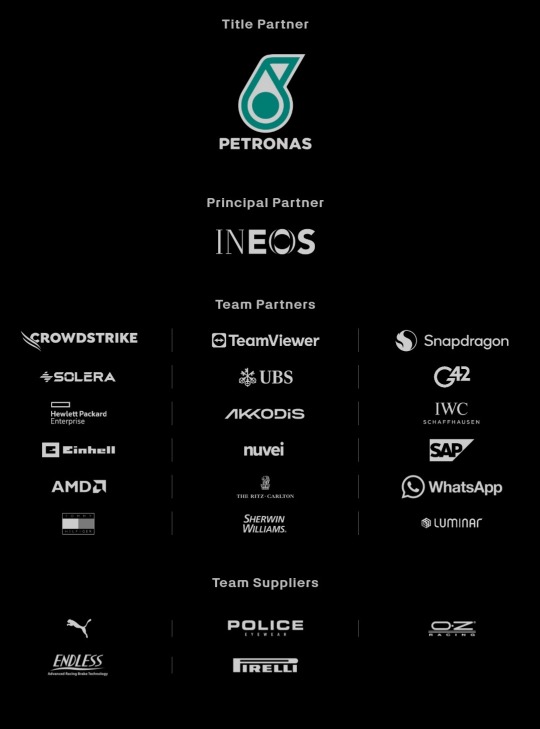
New sponsors: Whatsapp, Luminar (American tech company), SAP (German software company), nuvei (Canadian credit card services), Sherwin Williams (American painting company) 2024 data last update: 2024/02/14
Old sponsors that left: Monster Energy, Pure Storage (American technology company), fastly (American cloud computing services), Axalta (American painting company), Eight sleep (American mattresses company) 2023 data last update: 2023/01/07
Oracle Red Bull Racing F1 Team:
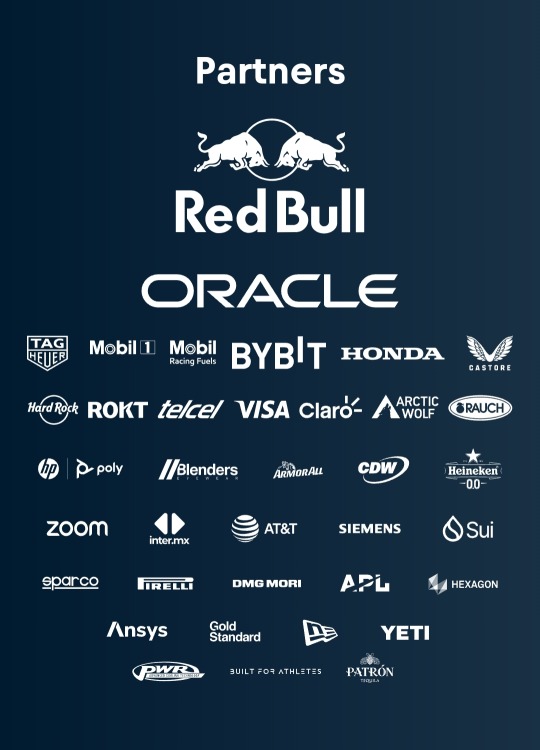
New sponsors: Yeti (American cooler manufacturer, joined later in 2023), APL (American footwear/athletic apparel manufacturer, joined later in 2023), CDW (American IT company, joined later in 2023), Sui (American tech app by Mysten Labs, joined later in 2023), Patron Tequila (Mexican alcoholic beverages company, joined later in 2023) 2024 data last update: 2024/02/15
Old sponsors that left: CashApp, Walmart, Therabody (American wellness technology company), Ocean Bottle (Norwegian reusable bottle manufacturer), PokerStars (Costa Rican gambling site), Alpha Tauri (? no info if they're official partners or not but Austrian clothing company made by Red Bull), BMC (Switzerland bicycle/cycling manufacturer), Esso (American fuel company, subsidiary of ExxonMobil), Hewlett Packard Enterprise (American technology company) 2023 data last update: 2023/03/07
More: Esso is a subsidiary of Mobil so there's possibility they merged or something
Scuderia Ferrari:

New sponsors: VGW Play (Australian tech game company, joined later in 2023), DXC Technology (American IT company, joined later in 2023), Peroni (Italian brewing company), Z Capital Group/ZCG (American private asset management/merchant bank company), Celsius (Swedish energy drink manufacturer) 2024 data last update: 2024/02/15
Old sponsors that left: Mission Winnow (American content lab by Phillip Morris International aka Marlboro), Estrella Garcia (Spanish alcoholic beverages manufacturer), Frecciarossa (Italian high speed train company) 2023 data last update: 2023/02/16
More: Mission Winnow is a part of Phillip Morris International. They are no longer listed as team sponsor but PMI is listed instead.
(starting here, 2023 data last update is 2023/02/23 and 2024 data last update is 2024/02/15)
McLaren F1 Team: (Only McLaren RACING's data is available idk if some of these are XE/FE team partners but anw..)
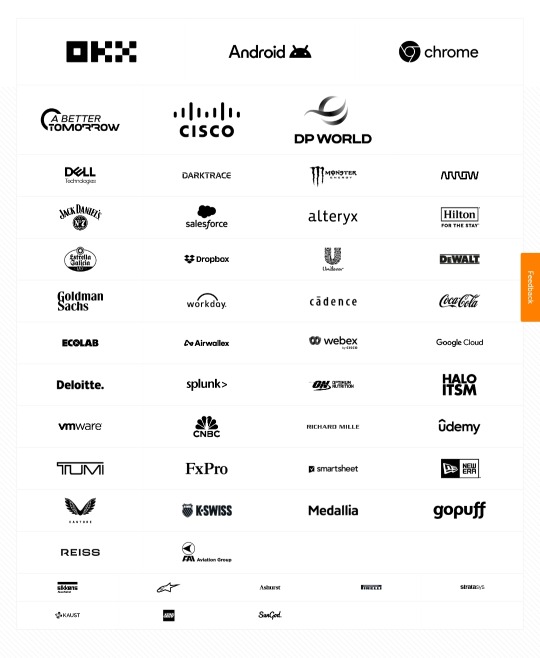
New sponsors: Monster Energy, Salesforce (American cloud based software company, joined later in 2023), Estrella Garcia (Spanish alcoholic beverages manufacturer), Dropbox (American file hosting company), Workday (American system software company, joined later in 2023), Ecolab (American water purification/hygiene company), Airwallex (Australian financial tech company), Optimum Nutrition (American nutritional supplement manufacturer), Halo ITSM (American software company, joined later in 2023), Udemy (American educational tech company, joined later in 2023), New Era (American cap manufacturer, joined in 2023), K-Swiss (American shoes manufacturer, joined later in 2023), Alpinestars (Italian motorsports safety equipment manufacturer)
Old sponsors that left: DP World (Emirati logistics company), EasyPost (American shipping API company), Immersive Labs (UK cybersecurity training company?), Logitech, Mind (UK mental health charity), PartyCasino (UK? online casino site), PartyPoker (American? gambling site), Sparco (Italian auto part & accessory manufacturer), Tezos (Switzerland crypto company)
Aston Martin Aramco F1 Team:

New sponsors: Valvoline (American retail automotives service company, joined later in 2023), NexGen (Canadian sustainable? fuel company), Banco Master (Brazilian digital banking platform, joined later in 2023), ServiceNow (American software company, joined later in 2023), Regent Seven Seas Cruise, Wolfgang Puck (Austrian-American chef and restaurant owner, joined later in 2023), Financial Times (British business newspaper), OMP (Italian racing safety equipment manufacturer), stichd (Netherlands fashion & apparel manufacturer)
Old sponsors that left: Alpinestars (Italian motorsports safety equipment manufacturer), crypto.com (Singaporean cryptocurrency company), ebb3 (UK? software company), Pelmark (UK fashion and apparel manufacturer), Peroni (Italian brewing company), Porto Seguro (Brazilian insurance company), Socios (Malta's blockchain-based platform), XP (Brazilian investment company)
Stake F1 Team (prev. Alfa Romeo):
???? Can't found their website (might be geoblocked in my country???)
BWT Alpine F1 Team:

New sponsors: MNTN (American software company), H. Moser & Cie (Switzerland watch manufacturer), Amazon Music
Old sponsors that left: Bell & Ross (French watch company), Ecowatt (??? afaik French less-energy smthn smthn company), Elysium (French? American? Software company), KX (UK software company), Plug (American electrical equipment manufacturing company)
Visa CashApp RB F1 Team (prev. Scuderia Alpha Tauri):

New Sponsors: Visa, CashApp, Hugo Boss, Tudor, Neft Vodka (Austrian alcoholic beverages company), Piquadro (Italian luxury bag manufacturer)
Old sponsors that left: Buzz (?), Carl Friedrik (UK travel goods manufacturer), Flex Box (Hongkong? shipping containers manufacturer), GMG (Emirati global wellbeing company), RapidAPI (American API company)
Haas F1 Team:

New sponsors: New Era (American cap manufacturer, joined later in 2023)
Old sponsors that left: Hantec Markets (Hongkong capital markets company), OpenSea (American NFT/Crypto company)
Williams Racing:


New sponsors: Komatsu, MyProtein (British bodybuilding supplement), Kraken (American crypto company, joined later in 2023), VAST Data (American tech company), Ingenuity Commerce (UK e-commerce platform), Puma (joined later in 2023)
Old sponsors that left: Acronis (Swiss software company), Bremont (British watch manufacturer), Dtex Systems (American? cybersecurity company), Financial Times (British business newspaper), Jumeirah Hotels & Resorts, KX (UK software company), OMP (Italian racing safety equipment manufacturer), PPG (American painting manufacturer), Umbro (English sports equipment manufacturer), Zeiss (German opticals/optometrics manufacturing company)
#mercedes amg petronas#red bull racing#scuderia ferrari#visa cash app rb#haas f1 team#mclaren f1#aston martin#alpine f1#williams racing#stake f1 team#f1#ari's rant#sponsor talks
42 notes
·
View notes
Text
For years, hashing technology has made it possible for platforms to automatically detect known child sexual abuse materials (CSAM) to stop kids from being retraumatized online. However, rapidly detecting new or unknown CSAM remained a bigger challenge for platforms as new victims continued to be victimized. Now, AI may be ready to change that.
Today, a prominent child safety organization, Thorn, in partnership with a leading cloud-based AI solutions provider, Hive, announced the release of an API expanding access to an AI model designed to flag unknown CSAM. It's the earliest use of AI technology striving to expose unreported CSAM at scale.
An expansion of Thorn's CSAM detection tool, Safer, the AI feature uses "advanced machine learning (ML) classification models" to "detect new or previously unreported CSAM," generating a "risk score to make human decisions easier and faster."
The model was trained in part using data from the National Center for Missing and Exploited Children (NCMEC) CyberTipline, relying on real CSAM data to detect patterns in harmful images and videos. Once suspected CSAM is flagged, a human reviewer remains in the loop to ensure oversight. It could potentially be used to probe suspected CSAM rings proliferating online.
It could also, of course, make mistakes, but Kevin Guo, Hive's CEO, told Ars that extensive testing was conducted to reduce false positives or negatives substantially. While he wouldn't share stats, he said that platforms would not be interested in a tool where "99 out of a hundred things the tool is flagging aren't correct."
9 notes
·
View notes
Text
Who Is a Technical Writer?
A technical writer is a professional who creates clear, concise documentation that explains complex information in a way that's easy to understand. They translate technical concepts into user-friendly content.
---
What Do They Write?
Technical writers produce a wide range of materials, including:
User manuals
Instruction guides
Product documentation
How-to articles
API documentation
Standard Operating Procedures (SOPs)
White papers
Training materials
Online help systems
Software release notes
---
Where Do They Work?
Industries that employ technical writers include:
Tech/software companies
Engineering firms
Medical and healthcare
Manufacturing
Finance
Government agencies
Telecommunications
---
Key Skills of a Technical Writer
1. Excellent writing and communication
2. Ability to understand complex technical information
3. Attention to detail
4. Research and interviewing skills
5. Organization and clarity
6. Collaboration with engineers, designers, developers, etc.
7. Basic design and formatting skills
---
Popular Tools Used
Microsoft Word / Google Docs
Markdown editors
Adobe FrameMaker / InDesign
MadCap Flare
Confluence / Jira
Snagit / Camtasia (for visuals and screen recordings)
Git / GitHub (for version control)
XML / HTML / CSS (basic web formatting)
---
Education & Background
A bachelor’s degree in English, Communications, Technical Writing, Engineering, or Computer Science is common.
Certifications can help (e.g., from the Society for Technical Communication (STC) or Coursera).
Some come from writing backgrounds; others transition from technical fields (like software development or engineering).
---
Career Path & Growth
Junior Technical Writer → Technical Writer → Senior Technical Writer
Specializations: API writer, UX writer, Information Architect, Content Strategist, etc.
Many go freelance or work as consultants.
Remote work is common in this field.
---
Why It's a Good Career
High demand, especially in tech
Remote flexibility
Well-paying (entry level: $50k–$70k; senior roles: $90k+)
Good for writers with an analytical mind
2 notes
·
View notes
Text
Why Python Will Thrive: Future Trends and Applications
Python has already made a significant impact in the tech world, and its trajectory for the future is even more promising. From its simplicity and versatility to its widespread use in cutting-edge technologies, Python is expected to continue thriving in the coming years. Considering the kind support of Python Course in Chennai Whatever your level of experience or reason for switching from another programming language, learning Python gets much more fun.

Let's explore why Python will remain at the forefront of software development and what trends and applications will contribute to its ongoing dominance.
1. Artificial Intelligence and Machine Learning
Python is already the go-to language for AI and machine learning, and its role in these fields is set to expand further. With powerful libraries such as TensorFlow, PyTorch, and Scikit-learn, Python simplifies the development of machine learning models and artificial intelligence applications. As more industries integrate AI for automation, personalization, and predictive analytics, Python will remain a core language for developing intelligent systems.
2. Data Science and Big Data
Data science is one of the most significant areas where Python has excelled. Libraries like Pandas, NumPy, and Matplotlib make data manipulation and visualization simple and efficient. As companies and organizations continue to generate and analyze vast amounts of data, Python’s ability to process, clean, and visualize big data will only become more critical. Additionally, Python’s compatibility with big data platforms like Hadoop and Apache Spark ensures that it will remain a major player in data-driven decision-making.
3. Web Development
Python’s role in web development is growing thanks to frameworks like Django and Flask, which provide robust, scalable, and secure solutions for building web applications. With the increasing demand for interactive websites and APIs, Python is well-positioned to continue serving as a top language for backend development. Its integration with cloud computing platforms will also fuel its growth in building modern web applications that scale efficiently.
4. Automation and Scripting
Automation is another area where Python excels. Developers use Python to automate tasks ranging from system administration to testing and deployment. With the rise of DevOps practices and the growing demand for workflow automation, Python’s role in streamlining repetitive processes will continue to grow. Businesses across industries will rely on Python to boost productivity, reduce errors, and optimize performance. With the aid of Best Online Training & Placement Programs, which offer comprehensive training and job placement support to anyone looking to develop their talents, it’s easier to learn this tool and advance your career.

5. Cybersecurity and Ethical Hacking
With cyber threats becoming increasingly sophisticated, cybersecurity is a critical concern for businesses worldwide. Python is widely used for penetration testing, vulnerability scanning, and threat detection due to its simplicity and effectiveness. Libraries like Scapy and PyCrypto make Python an excellent choice for ethical hacking and security professionals. As the need for robust cybersecurity measures increases, Python’s role in safeguarding digital assets will continue to thrive.
6. Internet of Things (IoT)
Python’s compatibility with microcontrollers and embedded systems makes it a strong contender in the growing field of IoT. Frameworks like MicroPython and CircuitPython enable developers to build IoT applications efficiently, whether for home automation, smart cities, or industrial systems. As the number of connected devices continues to rise, Python will remain a dominant language for creating scalable and reliable IoT solutions.
7. Cloud Computing and Serverless Architectures
The rise of cloud computing and serverless architectures has created new opportunities for Python. Cloud platforms like AWS, Google Cloud, and Microsoft Azure all support Python, allowing developers to build scalable and cost-efficient applications. With its flexibility and integration capabilities, Python is perfectly suited for developing cloud-based applications, serverless functions, and microservices.
8. Gaming and Virtual Reality
Python has long been used in game development, with libraries such as Pygame offering simple tools to create 2D games. However, as gaming and virtual reality (VR) technologies evolve, Python’s role in developing immersive experiences will grow. The language’s ease of use and integration with game engines will make it a popular choice for building gaming platforms, VR applications, and simulations.
9. Expanding Job Market
As Python’s applications continue to grow, so does the demand for Python developers. From startups to tech giants like Google, Facebook, and Amazon, companies across industries are seeking professionals who are proficient in Python. The increasing adoption of Python in various fields, including data science, AI, cybersecurity, and cloud computing, ensures a thriving job market for Python developers in the future.
10. Constant Evolution and Community Support
Python’s open-source nature means that it’s constantly evolving with new libraries, frameworks, and features. Its vibrant community of developers contributes to its growth and ensures that Python stays relevant to emerging trends and technologies. Whether it’s a new tool for AI or a breakthrough in web development, Python’s community is always working to improve the language and make it more efficient for developers.
Conclusion
Python’s future is bright, with its presence continuing to grow in AI, data science, automation, web development, and beyond. As industries become increasingly data-driven, automated, and connected, Python’s simplicity, versatility, and strong community support make it an ideal choice for developers. Whether you are a beginner looking to start your coding journey or a seasoned professional exploring new career opportunities, learning Python offers long-term benefits in a rapidly evolving tech landscape.
#python course#python training#python#technology#tech#python programming#python online training#python online course#python online classes#python certification
2 notes
·
View notes
Text
The Role of AI in Modern Software Testing Practices
AI is reshaping the way software testing is done. With AI automated testing, businesses can achieve higher efficiency, better accuracy, and faster software releases. Whether it’s AI software testing, AI generator testers, or AI-driven automation, the future of software testing is AI-powered.
#ai generator tester#ai software testing#ai automated testing#ai in testing software#playwright automation javascript#playwright javascript tutorial#playwright python tutorial#scrapy playwright tutorial#api testing using postman#online postman api testing#postman automation api testing#postman automated testing#postman performance testing#postman tutorial for api testing#free api for postman testing#api testing postman tutorial#postman tutorial for beginners#postman api performance testing#automate api testing in postman#java automation testing#automation testing selenium with java#automation testing java selenium#java selenium automation testing#python selenium automation#selenium with python automation testing#selenium testing with python#automation with selenium python#selenium automation with python#python and selenium tutorial#cypress automation training
0 notes
Text
Adobe Experience Manager Services USA: Empowering Digital Transformation
Introduction
In today's digital-first world, Adobe Experience Manager (AEM) Services USA have become a key driver for businesses looking to optimize their digital experiences, streamline content management, and enhance customer engagement. AEM is a powerful content management system (CMS) that integrates with AI and cloud technologies to provide scalable, secure, and personalized digital solutions.
With the rapid evolution of online platforms, enterprises across industries such as e-commerce, healthcare, finance, and media are leveraging AEM to deliver seamless and engaging digital experiences. In this blog, we explore how AEM services in the USA are revolutionizing digital content management and highlight the leading AEM service providers offering cutting-edge solutions.
Why Adobe Experience Manager Services Are Essential for Enterprises
AEM is an advanced digital experience platform that enables businesses to create, manage, and optimize digital content efficiently. Companies that implement AEM services in the USA benefit from:
Unified Content Management: Manage web, mobile, and digital assets seamlessly from a centralized platform.
Omnichannel Content Delivery: Deliver personalized experiences across multiple touchpoints, including websites, mobile apps, and IoT devices.
Enhanced User Experience: Leverage AI-driven insights and automation to create engaging and personalized customer interactions.
Scalability & Flexibility: AEM’s cloud-based architecture allows businesses to scale their content strategies efficiently.
Security & Compliance: Ensure data security and regulatory compliance with enterprise-grade security features.
Key AEM Services Driving Digital Transformation in the USA
Leading AEM service providers in the USA offer a comprehensive range of solutions tailored to enterprise needs:
AEM Sites Development: Build and manage responsive, high-performance websites with AEM’s powerful CMS capabilities.
AEM Assets Management: Store, organize, and distribute digital assets effectively with AI-driven automation.
AEM Headless CMS Implementation: Deliver content seamlessly across web, mobile, and digital channels through API-driven content delivery.
AEM Cloud Migration: Migrate to Adobe Experience Manager as a Cloud Service for improved agility, security, and scalability.
AEM Personalization & AI Integration: Utilize Adobe Sensei AI to deliver real-time personalized experiences.
AEM Consulting & Support: Get expert guidance, training, and support to optimize AEM performance and efficiency.
Key Factors Defining Top AEM Service Providers in the USA
Choosing the right AEM partner is crucial for successful AEM implementation in the USA. The best AEM service providers excel in:
Expertise in AEM Development & Customization
Leading AEM companies specialize in custom AEM development, ensuring tailored solutions that align with business goals.
Cloud-Based AEM Solutions
Cloud-native AEM services enable businesses to scale and manage content efficiently with Adobe Experience Manager as a Cloud Service.
Industry-Specific AEM Applications
Customized AEM solutions cater to specific industry needs, from e-commerce personalization to financial services automation.
Seamless AEM Integration
Top providers ensure smooth integration of AEM with existing enterprise tools such as CRM, ERP, and marketing automation platforms.
End-to-End AEM Support & Optimization
Comprehensive support services include AEM migration, upgrades, maintenance, and performance optimization.
Top AEM Service Providers in the USA
Leading AEM service providers offer a range of solutions to help businesses optimize their Adobe Experience Manager implementations. These services include:
AEM Strategy & Consulting
Expert guidance on AEM implementation, cloud migration, and content strategy.
AEM Cloud Migration & Integration
Seamless migration from on-premise to AEM as a Cloud Service, ensuring scalability and security.
AEM Development & Customization
Tailored solutions for AEM components, templates, workflows, and third-party integrations.
AEM Performance Optimization
Enhancing site speed, caching, and content delivery for improved user experiences.
AEM Managed Services & Support
Ongoing maintenance, upgrades, and security monitoring for optimal AEM performance.
The Future of AEM Services in the USA
The future of AEM services in the USA is driven by advancements in AI, machine learning, and cloud computing. Key trends shaping AEM’s evolution include:
AI-Powered Content Automation: AEM’s AI capabilities, such as Adobe Sensei, enhance content personalization and automation.
Headless CMS for Omnichannel Delivery: AEM’s headless CMS capabilities enable seamless content delivery across web, mobile, and IoT.
Cloud-First AEM Deployments: The shift towards Adobe Experience Manager as a Cloud Service is enabling businesses to achieve better performance and scalability.
Enhanced Data Security & Compliance: With growing concerns about data privacy, AEM service providers focus on GDPR and HIPAA-compliant solutions.
Conclusion:
Elevate Your Digital Experience with AEM Services USA
As businesses embrace digital transformation, Adobe Experience Manager services in the USA provide a powerful, scalable, and AI-driven solution to enhance content management and customer engagement. Choosing the right AEM partner ensures seamless implementation, personalized experiences, and improved operational efficiency.
🚀 Transform your digital strategy today by partnering with a top AEM service provider in the USA. The future of digital experience management starts with AEM—empowering businesses to deliver exceptional content and customer experiences!
3 notes
·
View notes
Text
What is Python, How to Learn Python?
What is Python?
Python is a high-level, interpreted programming language known for its simplicity and readability. It is widely used in various fields like: ✅ Web Development (Django, Flask) ✅ Data Science & Machine Learning (Pandas, NumPy, TensorFlow) ✅ Automation & Scripting (Web scraping, File automation) ✅ Game Development (Pygame) ✅ Cybersecurity & Ethical Hacking ✅ Embedded Systems & IoT (MicroPython)
Python is beginner-friendly because of its easy-to-read syntax, large community, and vast library support.
How Long Does It Take to Learn Python?
The time required to learn Python depends on your goals and background. Here’s a general breakdown:
1. Basics of Python (1-2 months)
If you spend 1-2 hours daily, you can master:
Variables, Data Types, Operators
Loops & Conditionals
Functions & Modules
Lists, Tuples, Dictionaries
File Handling
Basic Object-Oriented Programming (OOP)
2. Intermediate Level (2-4 months)
Once comfortable with basics, focus on:
Advanced OOP concepts
Exception Handling
Working with APIs & Web Scraping
Database handling (SQL, SQLite)
Python Libraries (Requests, Pandas, NumPy)
Small real-world projects
3. Advanced Python & Specialization (6+ months)
If you want to go pro, specialize in:
Data Science & Machine Learning (Matplotlib, Scikit-Learn, TensorFlow)
Web Development (Django, Flask)
Automation & Scripting
Cybersecurity & Ethical Hacking
Learning Plan Based on Your Goal
📌 Casual Learning – 3-6 months (for automation, scripting, or general knowledge) 📌 Professional Development – 6-12 months (for jobs in software, data science, etc.) 📌 Deep Mastery – 1-2 years (for AI, ML, complex projects, research)
Scope @ NareshIT:
At NareshIT’s Python application Development program you will be able to get the extensive hands-on training in front-end, middleware, and back-end technology.
It skilled you along with phase-end and capstone projects based on real business scenarios.
Here you learn the concepts from leading industry experts with content structured to ensure industrial relevance.
An end-to-end application with exciting features
Earn an industry-recognized course completion certificate.
For more details:
#classroom#python#education#learning#teaching#institute#marketing#study motivation#studying#onlinetraining
2 notes
·
View notes
Text
Exploring the Azure Technology Stack: A Solution Architect’s Journey
Kavin
As a solution architect, my career revolves around solving complex problems and designing systems that are scalable, secure, and efficient. The rise of cloud computing has transformed the way we think about technology, and Microsoft Azure has been at the forefront of this evolution. With its diverse and powerful technology stack, Azure offers endless possibilities for businesses and developers alike. My journey with Azure began with Microsoft Azure training online, which not only deepened my understanding of cloud concepts but also helped me unlock the potential of Azure’s ecosystem.
In this blog, I will share my experience working with a specific Azure technology stack that has proven to be transformative in various projects. This stack primarily focuses on serverless computing, container orchestration, DevOps integration, and globally distributed data management. Let’s dive into how these components come together to create robust solutions for modern business challenges.

Understanding the Azure Ecosystem
Azure’s ecosystem is vast, encompassing services that cater to infrastructure, application development, analytics, machine learning, and more. For this blog, I will focus on a specific stack that includes:
Azure Functions for serverless computing.
Azure Kubernetes Service (AKS) for container orchestration.
Azure DevOps for streamlined development and deployment.
Azure Cosmos DB for globally distributed, scalable data storage.
Each of these services has unique strengths, and when used together, they form a powerful foundation for building modern, cloud-native applications.
1. Azure Functions: Embracing Serverless Architecture
Serverless computing has redefined how we build and deploy applications. With Azure Functions, developers can focus on writing code without worrying about managing infrastructure. Azure Functions supports multiple programming languages and offers seamless integration with other Azure services.
Real-World Application
In one of my projects, we needed to process real-time data from IoT devices deployed across multiple locations. Azure Functions was the perfect choice for this task. By integrating Azure Functions with Azure Event Hubs, we were able to create an event-driven architecture that processed millions of events daily. The serverless nature of Azure Functions allowed us to scale dynamically based on workload, ensuring cost-efficiency and high performance.
Key Benefits:
Auto-scaling: Automatically adjusts to handle workload variations.
Cost-effective: Pay only for the resources consumed during function execution.
Integration-ready: Easily connects with services like Logic Apps, Event Grid, and API Management.
2. Azure Kubernetes Service (AKS): The Power of Containers
Containers have become the backbone of modern application development, and Azure Kubernetes Service (AKS) simplifies container orchestration. AKS provides a managed Kubernetes environment, making it easier to deploy, manage, and scale containerized applications.
Real-World Application
In a project for a healthcare client, we built a microservices architecture using AKS. Each service—such as patient records, appointment scheduling, and billing—was containerized and deployed on AKS. This approach provided several advantages:
Isolation: Each service operated independently, improving fault tolerance.
Scalability: AKS scaled specific services based on demand, optimizing resource usage.
Observability: Using Azure Monitor, we gained deep insights into application performance and quickly resolved issues.
The integration of AKS with Azure DevOps further streamlined our CI/CD pipelines, enabling rapid deployment and updates without downtime.
Key Benefits:
Managed Kubernetes: Reduces operational overhead with automated updates and patching.
Multi-region support: Enables global application deployments.
Built-in security: Integrates with Azure Active Directory and offers role-based access control (RBAC).
3. Azure DevOps: Streamlining Development Workflows
Azure DevOps is an all-in-one platform for managing development workflows, from planning to deployment. It includes tools like Azure Repos, Azure Pipelines, and Azure Artifacts, which support collaboration and automation.
Real-World Application
For an e-commerce client, we used Azure DevOps to establish an efficient CI/CD pipeline. The project involved multiple teams working on front-end, back-end, and database components. Azure DevOps provided:
Version control: Using Azure Repos for centralized code management.
Automated pipelines: Azure Pipelines for building, testing, and deploying code.
Artifact management: Storing dependencies in Azure Artifacts for seamless integration.
The result? Deployment cycles that previously took weeks were reduced to just a few hours, enabling faster time-to-market and improved customer satisfaction.
Key Benefits:
End-to-end integration: Unifies tools for seamless development and deployment.
Scalability: Supports projects of all sizes, from startups to enterprises.
Collaboration: Facilitates team communication with built-in dashboards and tracking.

4. Azure Cosmos DB: Global Data at Scale
Azure Cosmos DB is a globally distributed, multi-model database service designed for mission-critical applications. It guarantees low latency, high availability, and scalability, making it ideal for applications requiring real-time data access across multiple regions.
Real-World Application
In a project for a financial services company, we used Azure Cosmos DB to manage transaction data across multiple continents. The database’s multi-region replication ensure data consistency and availability, even during regional outages. Additionally, Cosmos DB’s support for multiple APIs (SQL, MongoDB, Cassandra, etc.) allowed us to integrate seamlessly with existing systems.
Key Benefits:
Global distribution: Data is replicated across regions with minimal latency.
Flexibility: Supports various data models, including key-value, document, and graph.
SLAs: Offers industry-leading SLAs for availability, throughput, and latency.
Building a Cohesive Solution
Combining these Azure services creates a technology stack that is flexible, scalable, and efficient. Here’s how they work together in a hypothetical solution:
Data Ingestion: IoT devices send data to Azure Event Hubs.
Processing: Azure Functions processes the data in real-time.
Storage: Processed data is stored in Azure Cosmos DB for global access.
Application Logic: Containerized microservices run on AKS, providing APIs for accessing and manipulating data.
Deployment: Azure DevOps manages the CI/CD pipeline, ensuring seamless updates to the application.
This architecture demonstrates how Azure’s technology stack can address modern business challenges while maintaining high performance and reliability.
Final Thoughts
My journey with Azure has been both rewarding and transformative. The training I received at ACTE Institute provided me with a strong foundation to explore Azure’s capabilities and apply them effectively in real-world scenarios. For those new to cloud computing, I recommend starting with a solid training program that offers hands-on experience and practical insights.
As the demand for cloud professionals continues to grow, specializing in Azure’s technology stack can open doors to exciting opportunities. If you’re based in Hyderabad or prefer online learning, consider enrolling in Microsoft Azure training in Hyderabad to kickstart your journey.
Azure’s ecosystem is continuously evolving, offering new tools and features to address emerging challenges. By staying committed to learning and experimenting, we can harness the full potential of this powerful platform and drive innovation in every project we undertake.
#cybersecurity#database#marketingstrategy#digitalmarketing#adtech#artificialintelligence#machinelearning#ai
2 notes
·
View notes
Text
How-To IT
Topic: Core areas of IT
1. Hardware
• Computers (Desktops, Laptops, Workstations)
• Servers and Data Centers
• Networking Devices (Routers, Switches, Modems)
• Storage Devices (HDDs, SSDs, NAS)
• Peripheral Devices (Printers, Scanners, Monitors)
2. Software
• Operating Systems (Windows, Linux, macOS)
• Application Software (Office Suites, ERP, CRM)
• Development Software (IDEs, Code Libraries, APIs)
• Middleware (Integration Tools)
• Security Software (Antivirus, Firewalls, SIEM)
3. Networking and Telecommunications
• LAN/WAN Infrastructure
• Wireless Networking (Wi-Fi, 5G)
• VPNs (Virtual Private Networks)
• Communication Systems (VoIP, Email Servers)
• Internet Services
4. Data Management
• Databases (SQL, NoSQL)
• Data Warehousing
• Big Data Technologies (Hadoop, Spark)
• Backup and Recovery Systems
• Data Integration Tools
5. Cybersecurity
• Network Security
• Endpoint Protection
• Identity and Access Management (IAM)
• Threat Detection and Incident Response
• Encryption and Data Privacy
6. Software Development
• Front-End Development (UI/UX Design)
• Back-End Development
• DevOps and CI/CD Pipelines
• Mobile App Development
• Cloud-Native Development
7. Cloud Computing
• Infrastructure as a Service (IaaS)
• Platform as a Service (PaaS)
• Software as a Service (SaaS)
• Serverless Computing
• Cloud Storage and Management
8. IT Support and Services
• Help Desk Support
• IT Service Management (ITSM)
• System Administration
• Hardware and Software Troubleshooting
• End-User Training
9. Artificial Intelligence and Machine Learning
• AI Algorithms and Frameworks
• Natural Language Processing (NLP)
• Computer Vision
• Robotics
• Predictive Analytics
10. Business Intelligence and Analytics
• Reporting Tools (Tableau, Power BI)
• Data Visualization
• Business Analytics Platforms
• Predictive Modeling
11. Internet of Things (IoT)
• IoT Devices and Sensors
• IoT Platforms
• Edge Computing
• Smart Systems (Homes, Cities, Vehicles)
12. Enterprise Systems
• Enterprise Resource Planning (ERP)
• Customer Relationship Management (CRM)
• Human Resource Management Systems (HRMS)
• Supply Chain Management Systems
13. IT Governance and Compliance
• ITIL (Information Technology Infrastructure Library)
• COBIT (Control Objectives for Information Technologies)
• ISO/IEC Standards
• Regulatory Compliance (GDPR, HIPAA, SOX)
14. Emerging Technologies
• Blockchain
• Quantum Computing
• Augmented Reality (AR) and Virtual Reality (VR)
• 3D Printing
• Digital Twins
15. IT Project Management
• Agile, Scrum, and Kanban
• Waterfall Methodology
• Resource Allocation
• Risk Management
16. IT Infrastructure
• Data Centers
• Virtualization (VMware, Hyper-V)
• Disaster Recovery Planning
• Load Balancing
17. IT Education and Certifications
• Vendor Certifications (Microsoft, Cisco, AWS)
• Training and Development Programs
• Online Learning Platforms
18. IT Operations and Monitoring
• Performance Monitoring (APM, Network Monitoring)
• IT Asset Management
• Event and Incident Management
19. Software Testing
• Manual Testing: Human testers evaluate software by executing test cases without using automation tools.
• Automated Testing: Use of testing tools (e.g., Selenium, JUnit) to run automated scripts and check software behavior.
• Functional Testing: Validating that the software performs its intended functions.
• Non-Functional Testing: Assessing non-functional aspects such as performance, usability, and security.
• Unit Testing: Testing individual components or units of code for correctness.
• Integration Testing: Ensuring that different modules or systems work together as expected.
• System Testing: Verifying the complete software system’s behavior against requirements.
• Acceptance Testing: Conducting tests to confirm that the software meets business requirements (including UAT - User Acceptance Testing).
• Regression Testing: Ensuring that new changes or features do not negatively affect existing functionalities.
• Performance Testing: Testing software performance under various conditions (load, stress, scalability).
• Security Testing: Identifying vulnerabilities and assessing the software’s ability to protect data.
• Compatibility Testing: Ensuring the software works on different operating systems, browsers, or devices.
• Continuous Testing: Integrating testing into the development lifecycle to provide quick feedback and minimize bugs.
• Test Automation Frameworks: Tools and structures used to automate testing processes (e.g., TestNG, Appium).
19. VoIP (Voice over IP)
VoIP Protocols & Standards
• SIP (Session Initiation Protocol)
• H.323
• RTP (Real-Time Transport Protocol)
• MGCP (Media Gateway Control Protocol)
VoIP Hardware
• IP Phones (Desk Phones, Mobile Clients)
• VoIP Gateways
• Analog Telephone Adapters (ATAs)
• VoIP Servers
• Network Switches/ Routers for VoIP
VoIP Software
• Softphones (e.g., Zoiper, X-Lite)
• PBX (Private Branch Exchange) Systems
• VoIP Management Software
• Call Center Solutions (e.g., Asterisk, 3CX)
VoIP Network Infrastructure
• Quality of Service (QoS) Configuration
• VPNs (Virtual Private Networks) for VoIP
• VoIP Traffic Shaping & Bandwidth Management
• Firewall and Security Configurations for VoIP
• Network Monitoring & Optimization Tools
VoIP Security
• Encryption (SRTP, TLS)
• Authentication and Authorization
• Firewall & Intrusion Detection Systems
• VoIP Fraud DetectionVoIP Providers
• Hosted VoIP Services (e.g., RingCentral, Vonage)
• SIP Trunking Providers
• PBX Hosting & Managed Services
VoIP Quality and Testing
• Call Quality Monitoring
• Latency, Jitter, and Packet Loss Testing
• VoIP Performance Metrics and Reporting Tools
• User Acceptance Testing (UAT) for VoIP Systems
Integration with Other Systems
• CRM Integration (e.g., Salesforce with VoIP)
• Unified Communications (UC) Solutions
• Contact Center Integration
• Email, Chat, and Video Communication Integration
2 notes
·
View notes
Text
Best IT Courses In Bhubaneswar:- seeree services pvt ltd.
Introduction:- seeree is one of the best IT training institute and Software industry, features completely Industrial training on Python , PHP , .NET , C Programming,Java , IOT , AI , GD PI , ORACLE and ALL CERTIFICATION COURSES as well as provides seminar,cultural activity and jobs
Courses we provided:- 1) Java Fullstack 2) Python Fullstack 3) PHP Fullstack 4) Preplacement Training & Sp. Eng 5) .NET Fulstack 6) SEO/Digital Marketing 7) SAP 8) MERN 9) Software Testing 10)Data Analyst 11)Data Science 12)Data Engineering 13)PGDCA 14)Tally 15)Graphics Design
Course1:- Java Fullstack

A Class in Java is where we teach objects how to behave. Education at seeree means way to success. The way of teaching by corporate trainers will bloom your career. We have the best java training classes in Bhubaneswar. 100% Placement Support. Job Support Post Training. This course will give you a firm foundation in Java, commonly used programming language. Java technology is wide used currently. Java is a programming language and it is a platform. Hardware or software environment in which a program runs, known as a platform. Since Java has its own Runtime Environment (JRE) and API, it is called platform. Java programming language is designed to meet the challenges of application development in the context of heterogeneous, network-wide distributed environment. Java is an object-oriented programming (OOP) language that uses many common elements from other OOP languages, such as C++. Java is a complete platform for software development. Java is suitable for enterprise large scale applications.]
Course2:- Python Fullstack

Seeree offers best python course in Bhubaneswar with 100% job assurance and low fee. Learn from real time corporate trainers and experienced faculties. Groom your personality with our faculty. Seeree helps to build confidence in students to give exposure to their skills to the company.
Python is dynamically typed , compiled and interpreted , procedural and object oriented , generalized , general-purpose , platform independent programming language. Python is a high-level, structured, open-source programming language that can be used for a wide variety of programming tasks.
Course3:- PHP Fullstack

seeree is the best training institute which provide PHP Training courses in bhubaneswar and all over odisha We aim the students to learn and grow altogether with the need of IT firms.
PHP is a server scripting language, and a powerful tool for making dynamic and interactive Web pages. PHP is a widely-used, free, and efficient alternative to competitors such as Microsoft's ASP.
Course4:- Preplacement Training & Sp. Eng

Welcome to SEEREE Institute, where excellence meets opportunity. At SEEREE, we are dedicated to providing a transformative learning experience that empowers students to achieve their goals and contribute to a brighter future.
Our institute offers cutting-edge courses designed to meet the needs of the ever-evolving global landscape. With a team of highly qualified instructors and state-of-the-art facilities, we ensure a supportive and inspiring environment for learning and growth.
Whether you're here to develop new skills, explore innovative fields, or pursue personal and professional success, SEEREE Institute is the perfect place to begin your journey. Thank you for choosing us, and we look forward to being a part of your success story.
Course5:- .NET Fullstack

Seeree offers best .NET course in Bhubaneswar with 100% job assurance and low fee. Learn from real time corporate trainers and experienced faculties. Groom your personality with our faculty. Seeree helps to build confidence in students to give exposure to their skills to the company.
Course6:- SEO/Digital Marketing

In today's fast-paced digital world, businesses thrive on visibility, engagement, and strategic online presence. At SEEREE, we empower you with the skills and knowledge to master the art of Search Engine Optimization (SEO) and Digital Marketing.
Our comprehensive program is designed for beginners and professionals alike, covering everything from keyword research, on-page and off-page SEO, and content marketing, to social media strategies, PPC campaigns, and analytics.
With hands-on training, real-world projects, and guidance from industry experts, we ensure you're equipped to drive measurable results and excel in this dynamic field.
Join us at SEEREE Institute and take the first step towards becoming a leader in the digital marketing landscape!"
Course7:- SAP
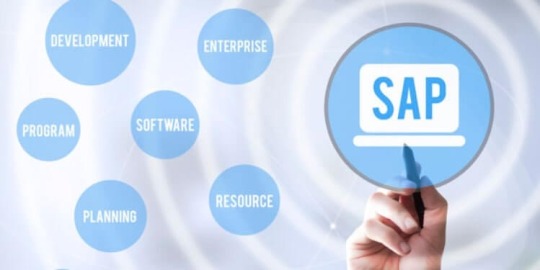
SAP refers to Systems, Applications, and Products in Data Processing. Some of the most common subjects covered in these courses include human resource software administration, database management, and business training. Obtaining SAP certification can be done on a stand-alone basis or as part of a degree program.
Course8:- MERN

Seeree offers the best MERN course in Bhubaneswar with 100% job assurance and low fees. Learn from real-time corporate trainers and experienced faculty. Seeree helps students build confidence and gain skills to excel in company roles.
Are you ready to step into the exciting world of web development? At SEEREE, we bring you a comprehensive MERN Stack course that equips you with the skills to build modern, dynamic, and responsive web applications from start to finish.
The MERN Stack—comprising MongoDB, Express.js, React.js, and Node.js—is one of the most sought-after technologies in the web development industry. Our program is designed to help you master each component of the stack, from creating robust backends and managing databases to crafting dynamic frontends and seamless APIs.
Course9:- Software Testing
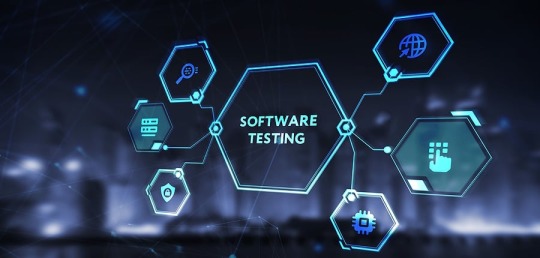
Seeree offers best Testing course in Bhubaneswar with 100% job assurance and low fee. Learn from real time corporate trainers and experienced faculties. Groom your personality with our faculty. Seeree helps to build confidence in students to give exposure to their skills to the company.
In the fast-paced world of software development, ensuring the quality and reliability of applications is crucial. At SEEREE, we offer a comprehensive Software Testing course designed to equip you with the skills and techniques needed to excel in this essential field.
Our program covers all aspects of software testing, from manual testing fundamentals to advanced automation tools and frameworks like Selenium, JIRA, and TestNG. You’ll learn to identify bugs, write test cases, execute test scripts, and ensure software meets high-quality standards.
With hands-on training, real-world scenarios, and guidance from experienced industry professionals, you’ll be prepared to take on roles like Quality Assurance Engineer, Test Analyst, and Automation Tester.
Join SEEREE Institute and gain the expertise to become a key player in delivering flawless software solutions. Your journey to a rewarding career in software testing starts here!"
Course10:- Data Analyst

Seeree offers the best Data Analyst course in Bhubaneswar with 100% job assurance and affordable fees. Our comprehensive curriculum is designed to cover all aspects of data analysis, from data collection and cleaning to advanced data visualization techniques. Learn from real-time corporate trainers and experienced faculty members who bring industry insights into the classroom. Enhance your analytical skills and boost your career prospects with hands-on projects and real-world case studies. Our faculty also focuses on grooming your personality and soft skills, ensuring you are well-prepared for interviews and workplace environments. Seeree is dedicated to building confidence in students, providing them with the necessary exposure to showcase their skills to top companies in the industry.
Course11:- Data Science

Seeree offers the best Data Science course in Bhubaneswar with 100% job assurance and affordable fees. Our comprehensive curriculum is designed to cover all aspects of data science, from data collection and cleaning to advanced data visualization techniques. Learn from real-time corporate trainers and experienced faculty members who bring industry insights into the classroom. Enhance your analytical skills and boost your career prospects with hands-on projects and real-world case studies. Our faculty also focuses on grooming your personality and soft skills, ensuring you are well-prepared for interviews and workplace environments. Seeree is dedicated to building confidence in students, providing them with the necessary exposure to showcase their skills to top companies in the industry.
Course12:- Data Engineering
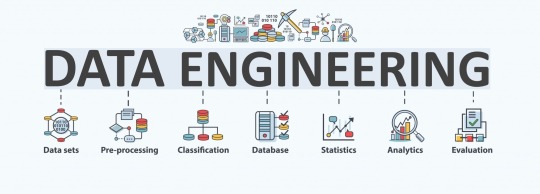
In the era of big data, the ability to design, build, and manage scalable data infrastructure is one of the most in-demand skills in the tech industry. At SEEREE, we are proud to offer a comprehensive Data Engineering course that prepares you for a career at the forefront of data-driven innovation.
Our program covers essential topics such as data modeling, ETL processes, data warehousing, cloud platforms, and tools like Apache Spark, Kafka, and Hadoop. You’ll learn how to collect, organize, and transform raw data into actionable insights, enabling businesses to make smarter decisions.
With real-world projects, expert mentorship, and hands-on experience with the latest technologies, we ensure that you are industry-ready. Whether you’re starting fresh or upskilling, this program will empower you to unlock opportunities in the rapidly growing field of data engineering.
Join SEEREE Institute and take the first step toward building the data pipelines that power tomorrow’s technology!"
Course13:- PGDCA

Seeree offers the best MERN course in Bhubaneswar with 100% job assurance and low fees. Learn from real-time corporate trainers and experienced faculty. Seeree helps students build confidence and gain skills to excel in company roles.
In today’s digital age, computer applications are at the heart of every industry, driving innovation and efficiency. At SEEREE Institute, our Post Graduate Diploma in Computer Applications (PGDCA) program is designed to provide you with in-depth knowledge and hands-on skills to excel in the IT world.
This program offers a comprehensive curriculum covering programming languages, database management, web development, software engineering, networking, and more. Whether you aim to enhance your technical expertise or step into a rewarding career in IT, PGDCA at SEEREE equips you with the tools to succeed.
With expert faculty, state-of-the-art labs, and real-world projects, we ensure that you gain practical experience and a strong theoretical foundation. By the end of the program, you’ll be prepared for roles such as software developer, system analyst, IT manager, or database administrator.
Course14:- Tally

Seeree offers the best Tally course in Bhubaneswar with 100% job assurance and low fees. Learn from real-time corporate trainers and experienced faculty. Seeree helps students build confidence and gain skills to excel in company roles.
In today’s business world, efficient financial management is key to success, and Tally is one of the most trusted tools for accounting and financial operations. At SEEREE Institute, we offer a comprehensive Tally course designed to equip you with the skills needed to manage business finances effortlessly.
Our program covers everything from the basics of accounting and bookkeeping to advanced features like GST compliance, inventory management, payroll processing, and generating financial reports. With hands-on training and real-world applications, you’ll gain practical expertise in using Tally effectively for businesses of any scale.
Whether you're a student, a professional, or a business owner, our Tally program is tailored to meet your needs and enhance your career prospects in the fields of accounting and finance.
Course15:- Graphics Design

In the world of creativity and communication, graphic design plays a vital role in bringing ideas to life. At SEEREE Institute, our Graphic Design course is tailored to help you unlock your creative potential and master the art of visual storytelling.
Our program covers a wide range of topics, including design principles, color theory, typography, branding, and user interface design. You’ll gain hands-on experience with industry-standard tools like Adobe Photoshop, Illustrator, and InDesign, enabling you to create stunning visuals for print, digital media, and beyond.
Whether you're an aspiring designer or a professional looking to sharpen your skills, our expert trainers and real-world projects will provide you with the knowledge and confidence to excel in this competitive field.
Join SEEREE Institute and start your journey toward becoming a skilled graphic designer. Let’s design your future together!"
2 notes
·
View notes